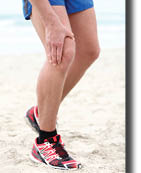History and Presenting Symptoms
 The patient is a 44-year-old male who describes persistent pain and occasional stiffness in his right knee that is not associated with any specific activity. He reports at least two years of recurring episodes of medial knee pain that just comes and goes with no swelling or inflammation. Previous evaluations, including a knee MRI, have resulted in a diagnosis of a torn meniscus. Surgery has been offered; but with no guarantee of significant pain reduction, he has declined to undergo arthroscopic repair.
The patient is a 44-year-old male who describes persistent pain and occasional stiffness in his right knee that is not associated with any specific activity. He reports at least two years of recurring episodes of medial knee pain that just comes and goes with no swelling or inflammation. Previous evaluations, including a knee MRI, have resulted in a diagnosis of a torn meniscus. Surgery has been offered; but with no guarantee of significant pain reduction, he has declined to undergo arthroscopic repair.Exam Findings
Vitals. This male patient weighs 170 lbs., which at 5’ 9.5’’ results in a BMI of 24.7. He is not overweight but getting close. He was a moderate cigarette smoker (eight per day) from his late teens into his mid-twenties, but he has been nicotine free for almost 20 years. His blood pressure and pulse rate are at the upper end of the normal range.
Posture and gait. Standing postural evaluation finds generally good alignment with a slight forward head carriage but otherwise intact spinal curves and a balanced pelvis. He has a mild bilateral knee valgus with moderate calcaneal eversion and hyperpronation on the right side. A tendency for the right foot to flare out is noted during gait screening.
Chiropractic evaluation. Motion palpation identifies a limitation in right sacroiliac (SI) movement with definite tenderness and loss of end-range mobility. Several compensatory subluxations are identified throughout the lumbar region. Otherwise, all spinal orthopedic and neurological testing is negative.
Primary complaint. Examination of his right knee finds no ligament instability and no limitation, pain, or “click” on McMurray testing. Mild pain and crepitus are found during Apley’s grinding test. All knee ranges of motion are full and pain free, bilaterally. Manual muscle testing finds mild weakness in the right sartorius muscle when compared to the left side.
Imaging
No X-rays or other forms of musculoskeletal imaging were requested since multiple X-rays and an MRI of the knee had been performed during the initial surgical discussion period.
Clinical Impression
Biomechanical asymmetry of the lower extremities with probable meniscal irritation at the right knee. This is accompanied by SI joint motion restriction and compensatory lumbar subluxations.
Treatment Plan
Adjustments. Specific, corrective adjustments for the SI joints and lumbar region were provided as needed. The right proximal tibia was adjusted into internal rotation with additional medial pressure for the valgus malposition.
Stabilization. Individually designed stabilizing orthotics were provided to support the arches, to decrease the medial pressure on his right knee, and to reduce the asymmetrical biomechanical forces being transmitted up the lower extremity to the pelvis and spine.
Rehabilitation. This patient performed daily exercises with elastic tubing to retrain and strengthen his right sartorius muscle for improved medial knee support. He also worked to strengthen internal rotation action of his right hip to decrease the tendency to toe out. In addition, he was supplied with a dietary supplement for joint health that contained glucosamine and chondroitin sulfates.
Response to Care
The spinal and extremity adjustments were well tolerated, but knee pain recurred until he had been regularly performing his rehab exercises for almost two weeks. He reported no difficulty in wearing the orthotics in all of his shoes. Over the next month, he described a noticeable improvement in his knee function with an eventual complete cessation of the previous pain and stiffness. He was released from active problem care to a self-directed home stretching program after a total of eight visits over six weeks.
Discussion
This patient had received the medical opinion that, at some point, surgery would be the only answer for his chronic knee pain. Fortunately, he persisted in searching for alternatives.
The combination of spinal and extremity adjustments, nutritional supplementation, and better support for the medial knee from improved muscle function and stabilizing orthotics resulted in an excellent response. In fact, he is now embarking on a wellness plan that includes addressing his lifestyle choices to improve his diet and overall health.
